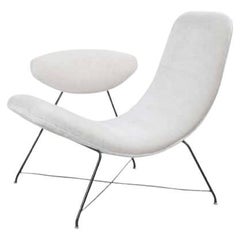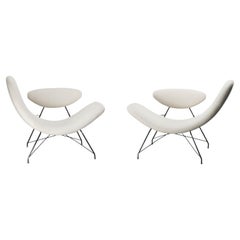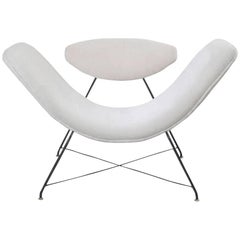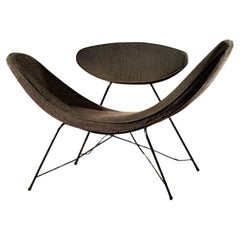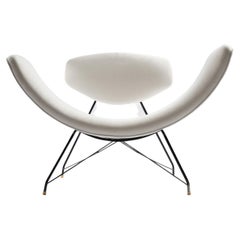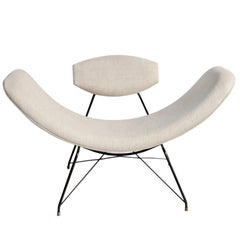Eisler Reversible
Vintage 1950s Brazilian Mid-Century Modern Lounge Chairs
Brass, Iron
Vintage 1950s Armchairs
Iron
Mid-20th Century Brazilian Mid-Century Modern Armchairs
Iron
Mid-20th Century Brazilian Mid-Century Modern Lounge Chairs
Iron
Recent Sales
Vintage 1960s Brazilian Post-Modern Armchairs
Metal, Brass
Vintage 1950s Brazilian Mid-Century Modern Armchairs
Iron
Vintage 1950s Brazilian Mid-Century Modern Lounge Chairs
Metal
Vintage 1950s Brazilian Mid-Century Modern Chairs
Metal
Vintage 1950s Brazilian Mid-Century Modern Chairs
Metal
Vintage 1950s Brazilian Mid-Century Modern Lounge Chairs
Brass, Iron
Vintage 1950s Brazilian Mid-Century Modern Lounge Chairs
Brass, Iron
Mid-20th Century Brazilian Mid-Century Modern Armchairs
Metal
Vintage 1950s Brazilian Mid-Century Modern Armchairs
Iron
Vintage 1950s Brazilian Mid-Century Modern Lounge Chairs
Brass, Iron
People Also Browsed
Mid-20th Century Italian Mid-Century Modern Lounge Chairs
Brass
2010s Italian Modern Wall Lights and Sconces
Brass
21st Century and Contemporary Portuguese Modern Center Tables
Wood
21st Century and Contemporary French Modern Chairs
Steel
2010s Scandinavian Modern Chandeliers and Pendants
Brass, Bronze
21st Century and Contemporary Swedish Mid-Century Modern Table Lamps
Textile
Vintage 1960s Brazilian Mid-Century Modern Lounge Chairs
Upholstery, Hardwood
2010s Italian Modern Chaise Longues
Leather, Wood
21st Century and Contemporary Portuguese Organic Modern Side Tables
Travertine
Mid-20th Century American Organic Modern Chaise Longues
Hide, Sheepskin, Walnut
Vintage 1970s Mid-Century Modern Lounge Chairs
Velvet, Wood
2010s American Modern Coffee and Cocktail Tables
Fiberglass
Vintage 1950s American Mid-Century Modern Lounge Chairs
Steel
2010s Italian Modern Chandeliers and Pendants
Alabaster, Brass
2010s Brazilian Post-Modern Chairs
Iron
Vintage 1960s French Daybeds
Elm
Eisler Reversible For Sale on 1stDibs
How Much is a Eisler Reversible?
Carlo Hauner and Martin Eisler for sale on 1stDibs
Forma began in São Paulo, under the leadership of Italian designer Carlo Hauner and Austrian architect and interior designer Martin Eisler. Hauner studied drawing and technical drawing at the Brera Academy in Milan. After participating in the Venice Biennale, he emigrated to São Paulo, where he established the furniture manufacturer Móveis Artesanal, for which Carlo and Martin — as well as Carlo’s brother Ernesto Hauner — would create a range of pieces for the home.
In 1936, Eisler earned a degree in architecture from the Academy of Fine Arts in Vienna, where he studied under Oskar Strnad and Clemens Holzmeister. With World War II looming, he left Austria immediately after graduating. He first went to Czechoslovakia, to which some of his family had already fled. In 1938, he moved to Buenos Aires, Argentina, and opened his interior design firm Interieur Forma.
Eisler relocated to Brazil in the early 1950s, where he met Hauner. At the time, Eisler had been looking for help producing furniture for his brother-in-law, Ernesto Wolf, and contacted Hauner. The two found that they had a shared vision, and with financial help from Wolf, they opened Galeria Artesanal as a storefront for Móveis Artesanal.
Looking to expand into international sales, the duo rebranded the company Forma. Sérgio Rodrigues, who helped launch a branch of Artesanal in Curitiba, was put in charge of interiors at Forma. That company soon became one of the biggest names in Brazilian furniture — it sold its own sculptural rattan lounge chairs, bookcases and other case pieces crafted with rosewood or jacaranda, and Forma was eventually distributing furniture licensed from iconic American manufacturer Knoll, thereby bringing works by noted designers such as Ludwig Mies van der Rohe, Charles Eames and Harry Bertoia to the Brazilian market.
Forma stands at the forefront of a revival of Brazilian modern furniture. Fashioned from high-grade regionally sourced hardwoods, leather and iron, even Forma's earliest creations have stood the test of time. The company’s alluring mid-century modern works appealed to homeowners at its peak, from the 1950s through the ’70s, and given the broadening interest in Brazilian furniture and the likes of designers such as Rodrigues, vintage Forma is making a major comeback today.
The Forma furniture company continued producing masterfully crafted furniture into the 1970s, until Eisler's death in 1977. Forma folded soon after, but Eisler's company in Argentina, Interieur Forma, is still in business today.
On 1stDibs, find vintage Carlo Hauner and Martin Eisler furniture for sale.
On the Origins of Brazil
More often than not, vintage mid-century Brazilian furniture designs, with their gleaming wood, soft leathers and inviting shapes, share a sensuous, unique quality that distinguishes them from the more rectilinear output of American and Scandinavian makers of the same era.
Commencing in the 1940s and '50s, a group of architects and designers transformed the local cultural landscape in Brazil, merging the modernist vernacular popular in Europe and the United States with the South American country's traditional techniques and indigenous materials.
Key mid-century influencers on Brazilian furniture design include natives Oscar Niemeyer, Sergio Rodrigues and José Zanine Caldas as well as such European immigrants as Joaquim Tenreiro, Jean Gillon and Jorge Zalszupin. These creators frequently collaborated; for instance, Niemeyer, an internationally acclaimed architect, commissioned many of them to furnish his residential and institutional buildings.
The popularity of Brazilian modern furniture has made household names of these designers and other greats. Their particular brand of modernism is characterized by an émigré point of view (some were Lithuanian, German, Polish, Ukrainian, Portuguese, and Italian), a preference for highly figured indigenous Brazilian woods, a reverence for nature as an inspiration and an atelier or small-production mentality.
Hallmarks of Brazilian mid-century design include smooth, sculptural forms and the use of native woods like rosewood, jacaranda and pequi. The work of designers today exhibits many of the same qualities, though with a marked interest in exploring new materials (witness the Campana Brothers' stuffed-animal chairs) and an emphasis on looking inward rather than to other countries for inspiration.
Find a collection of vintage Brazilian furniture on 1stDibs that includes chairs, sofas, tables and more.
Finding the Right Seating for You
With entire areas of our homes reserved for “sitting rooms,” the value of quality antique and vintage seating cannot be overstated.
Fortunately, the design of side chairs, armchairs and other lounge furniture — since what were, quite literally, the early perches of our ancestors — has evolved considerably.
Among the earliest standard seating furniture were stools. Egyptian stools, for example, designed for one person with no seat back, were x-shaped and typically folded to be tucked away. These rudimentary chairs informed the design of Greek and Roman stools, all of which were a long way from Sori Yanagi's Butterfly stool or Alvar Aalto's Stool 60. In the 18th century and earlier, seats with backs and armrests were largely reserved for high nobility.
The seating of today is more inclusive but the style and placement of chairs can still make a statement. Antique desk chairs and armchairs designed in the style of Louis XV, which eventually included painted furniture and were often made of rare woods, feature prominently curved legs as well as Chinese themes and varied ornaments. Much like the thrones of fairy tales and the regency, elegant lounges crafted in the Louis XV style convey wealth and prestige. In the kitchen, the dining chair placed at the head of the table is typically reserved for the head of the household or a revered guest.
Of course, with luxurious vintage or antique furnishings, every chair can seem like the best seat in the house. Whether your preference is stretching out on a plush sofa, such as the Serpentine, designed by Vladimir Kagan, or cozying up in a vintage wingback chair, there is likely to be a comfy classic or contemporary gem for you on 1stDibs.
With respect to the latest obsessions in design, cane seating has been cropping up everywhere, from sleek armchairs to lounge chairs, while bouclé fabric, a staple of modern furniture design, can be seen in mid-century modern, Scandinavian modern and Hollywood Regency furniture styles.
Admirers of the sophisticated craftsmanship and dark woods frequently associated with mid-century modern seating can find timeless furnishings in our expansive collection of lounge chairs, dining chairs and other items — whether they’re vintage editions or alluring official reproductions of iconic designs from the likes of Hans Wegner or from Charles and Ray Eames. Shop our inventory of Egg chairs, designed in 1958 by Arne Jacobsen, the Florence Knoll lounge chair and more.
No matter your style, the collection of unique chairs, sofas and other seating on 1stDibs is surely worthy of a standing ovation.
